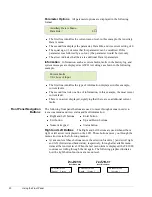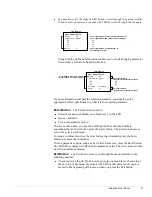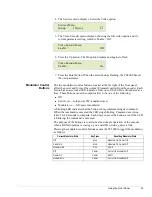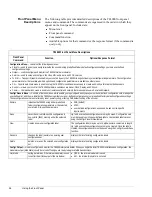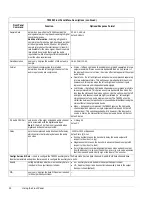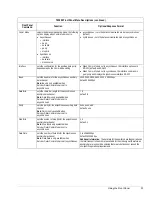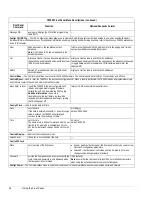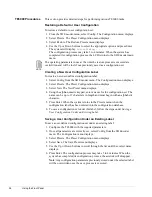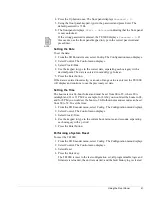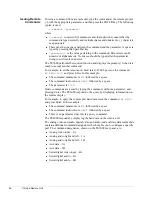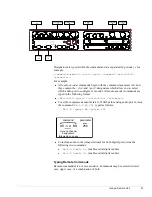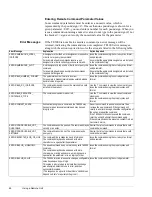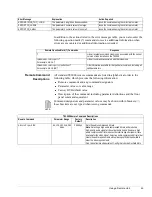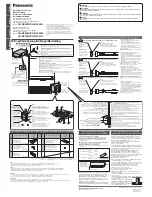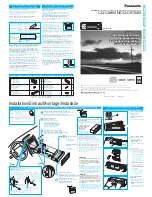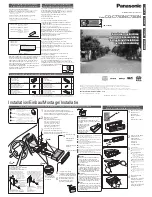
34
Using the Front Panel
Clock Source
sets the clock source for the synchronous auxiliary
data channel
Note: Clock Source is only available when
Service>Data>Comm Mode is set to synchronous.
!
internal – uses ST to latch the data (default)
!
external – uses TT to latch the data
Additional Information: Clock Source allows you to select either an Internal (ST) or an External (TT) clock to latch the input
auxiliary data (SD). There are three different ways to configure the clock sources for the TE3000 and a DTE. The following table
lists these different configurations along with the circumstances under which each is used.
!
The first option will produce the most reliable auxiliary data.
!
You should use the last option only if you are unable to configure your DTE for either of the first two options.
Circumstance For Use
TE3000 Data
TE3000 Clock
DTE Clock
DTE Clock
Clock Source
Used to
Source
Sent to
Configuration
Latch Data
Configuration
TE3000 on TT
Option 1: DTE is able to
Internal
TT
External
ST
turn around ST and provide
ST back to the TE3000 as TT.
Option 2: DTE is not able to
External
TT
Internal
Internal
turn around ST, but has an
internal clock that can be
provided to the TE3000 as TT.
Option 3: DTE is not able to
Internal
ST
External
None
turn around ST and does not
have an internal clock to
provide to the TE3000 as TT.
For more information on configuring the auxiliary data channel clock source, refer to the chapter on installing the TE3000.
Config>Service # >PCR — Used to set the program clock reference parameters
Delay
used to compensate for decoder buffering issues
-1000 to +1000 milliseconds
default: zero (0) msec
!
If the decoder’s buffer overflow, increase the PCR delay
!
If the decoders buffer underflow, decrease the PCR delay
Transmit Rate
sets the transmit rate of the PCR packet
0 to 100 Hz
Config>Tx Strm Menu — Enables you to set and query the TE3000 transport stream system configuration parameters. The configuration parameters set
at this level impact which options and configuration parameters are available on other menus.
Rate Calc
selects how the encoder determines the allocation
of data bit rates for the various transport stream
components including audio, video, and auxiliary
data bit rates
!
auto-video – the TE3000 determines and sets the video bit rate
automatically (default)
!
manual – you must manually calculate and then set the data bit rates for
video, audio, and auxiliary data
Additional Information: When Rate Calc is set to Auto, the video bit rate
setting is inversely proportional to the audio and user data bit rates; that is:
!
if the audio and user data bit rates are high, a smaller portion of the
transport stream bit rate can be allotted to the video bit rate
!
if the audio and user data bit rates are low, a larger portion of the transport
stream bit rate can be allotted to the video bit rate
Channel Mode
defines the application as an SCPC, MCPC, or
redundant system
!
SCPC – single-channel-per-carrier (default)
!
MCPC – multiple-channels-per-carrier
!
redundant – places the TE3000 in a redundant state; used when a system
is operating in a redundant, or protected, setup.
TE3000 Front Panel Menu Descriptions (continued)
Front Panel
Command
Function
Options/Response Format
Summary of Contents for TE3000
Page 10: ...viii Preface ...
Page 14: ...4 TE3000 Overview ...
Page 52: ...42 Using the Front Panel ...
Page 94: ...84 Maintenance and Software Upgrades ...
Page 96: ...86 Technical Specifications ...
Page 102: ...92 TE3000 PID Assignments ...
Page 112: ...102 Glossary ...

